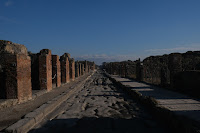In His Name
In the book of Acts, converts are baptized in water not long after receiving the Gospel. The process of conversion includes repentance, faith in the gospel, baptism in water, and the receipt of the gift of the Holy Spirit. While these are separate steps, they are closely related.
 |
| [Photo by Manuel Rheinschmidt on Unsplash] |
Before his ascension, Jesus commanded the disciples to “tarry in Jerusalem” until they received the Holy Spirit, “for John indeed baptized with water, but you will be baptized in the Holy Spirit.” This echoes what John said as he was ministering water baptism along the Jordan River:
- “I indeed baptize you with water, but there is coming he that is mightier than I… he will baptize you in the Holy Spirit and fire” – (Luke 3:16, Acts 1:4-5, 11:16).
JOHN’S BAPTISM
From the start, the
early church distinguished between the baptism of John and the baptism
administered to new converts. John’s baptism prepared hearts for the arrival of
the coming Messiah.
Jesus contrasted
John’s baptism with the baptism “in the Holy Spirit,” and not with later
Christian water baptism. John immersed penitent men and women in water, but the
disciples of Christ would be “immersed” in the Spirit.
The Greek term
rendered “baptize” or baptizô means to “immerse, dip, wash.” In classical Greek, it meant “immerse” as in fully submerging something
in water. The verb is from a root which means to make something “fully wet.”
When applied to the
Holy Spirit, “baptism” is metaphorical and illustrates a person’s full
“immersion” into the Spirit.
None of this means the
church abandoned the practice of baptizing individuals in water just because
believers were baptized in the Spirit. The two things are not mutually
exclusive but serve specific purposes.
PENTECOST
At the end of his
sermon on the Day of Pentecost, Peter summoned the crowd to repent and be “baptized every one of you in the name of Jesus Christ for the remission of your sins, and you will receive the gift of the Holy Spirit.” He associated
the gift of the Spirit closely with water baptism, though he also distinguished
between the two – (Acts 2:38).
Peter’s words do not mean that the Spirit is dispensed by water baptism, but the early church expected every convert to be baptized in water and receive the gift of the Spirit.
Water baptism was “for
the remission of sins,” and it certainly affirmed publicly that the convert
has repented and embraced the gospel. Peter’s statement about “receiving
the Spirit” reassured his audience that if they repented and were baptized, God
would certainly grant them the Spirit.
And according to Peter,
water baptism was administered by the early church “in the name of Jesus
Christ.”
SAMARIA
The gospel was first
preached in Samaria by Philip, and many of the Samaritans believed his
preaching “about the kingdom of God and
the name of Jesus Christ, and they were baptized, both men and women.”
While the passage
mentions the “name of Jesus Christ,” it does not state that these
converts were baptized in his name, or in any other name, only
that they were baptized. Noteworthy is that both “men and women”
underwent the same conversion process - (Acts 8:10-12).
Later, Philip shared
the gospel with the eunuch from Ethiopia. After hearing his words and seeing a
source of water, the eunuch asked for baptism. Upon hearing him confess that he
“believed that Jesus Christ is the Son of God,” Philip baptized
him in water.
Nothing is stated about
how Philip administered baptism to the eunuch or in what name. Nor does the
text discuss whether he received the Spirit at that time or later.
The story ends with
Philip whisked away by the Spirit, and the eunuch continuing his journey while “rejoicing”
– (Acts 8:5-39).
SAUL OF TARSUS
After his Damascus
Road encounter with Jesus, God sent a brother named Ananias to minister to Saul
of Tarsus. Ananias laid his hands on Saul and said, “Brother Saul, the Lord, even Jesus, who appeared to you in the way has sent me, that you may receive your sight and be filled with the Holy Spirit.” Saul
was healed and subsequently “baptized” – (Acts 9:17-18).
The passage does not
provide any details about Paul receiving the Spirit, and it provides minimal
information about his baptism in water. However, when Paul related the story years
later, he added that Ananias exhorted him to “be baptized and wash away your sins, calling on his
name.”
Once again, baptism is linked with the remission
of sins, and the last clause suggests Paul was baptized in the name of Jesus –
(Acts 22:16).
THE GENTILES
In the next chapter,
while Peter was preaching to the Gentiles gathered in the house of Cornelius,
the Holy Spirit “fell on them that heard the word.” This was confirmed when
Peter and his associates heard the Gentiles “speak with tongues and magnify God.” In response, they
were all “baptized in the name of Jesus Christ” – (Acts 10:44-48).
Although Peter’s summons on the Day of Pentecost suggests that receipt of the Spirit comes after water baptism, in this passage, believers received the Spirit BEFORE baptism. Once again, baptism was administered “in the name of Jesus Christ.”
Later, when the
jailer in Philippi asked what he must do, Paul declared, “Believe in the Lord Jesus and you will be saved, you and your house.”
After speaking the “word of the Lord” to the jailer and his household, the
Apostle “baptized” them. In whose name it was administered is not
stated. The passage does stress that they were baptized “immediately” –
(Acts 16:31-33).
EPHESUS AND CORINTH
In Ephesus, Paul met
several disciples of John the Baptist. When he asked whether they had received
the Holy Spirit, they replied they had not even heard about the Holy Spirit.
He next asked, “into
what were you baptized?” Upon hearing “into John’s baptism,” he
immediately baptized them “into the name of the Lord Jesus.” He and his companions laid hands on these men to
receive the Spirit, and “they spoke in tongues and prophesied.”
In Ephesus, water
baptism occurred in proximity to the receipt of the Spirit, and it preceded the latter.
The passage indicates no delay between the two events. And, once more, water
baptism was administered in the name of “the Lord Jesus.” Note well the
slight change from “Jesus Christ” to “Lord Jesus.”
In Corinth,
Crispus, the “ruler of the
synagogue, believed in the Lord with all his house, and many of the Corinthians
believed and were baptized.” Once again, a
simple statement is included about baptism. While no details are provided,
there is an underlying assumption that water baptism occurred after conversion
as a matter of course – (Acts 18:8).
SUMMARY
The book of Acts does demonstrate that new
converts were routinely baptized shortly after conversion. It was expected of
all followers of Jesus.
When Acts provides a rationale for doing so, baptism is “for the remission of sins.” In the more detailed descriptions, it is done in the “name of Jesus.”
There is no indication that initiates were given
lengthy instructions before baptism, or that there was any kind of probationary
period. Once someone repented, he or she was baptized in water in the name of
Jesus.
Water baptism is usually paired with baptism in
the Spirit. However, the two are distinct experiences. In Acts, the
Spirit is received by converts both before and after water baptism.
None of the relevant passages states directly that
converts are immersed completely in water. But “immersion” is the meaning of
the Greek verb, not “sprinkle” or “pour.” Without any contradictory evidence,
the word should be given its original sense when administering baptism.
Finally, nowhere does the book of Acts
claim or suggest that water baptism must be administered by an apostle. While
we find several of the apostles baptizing converts, neither Philip the
Evangelist nor Ananias were apostles, yet the former baptized the eunuch, and
the latter Saul of Tarsus, the future “apostle to the Gentiles.”

